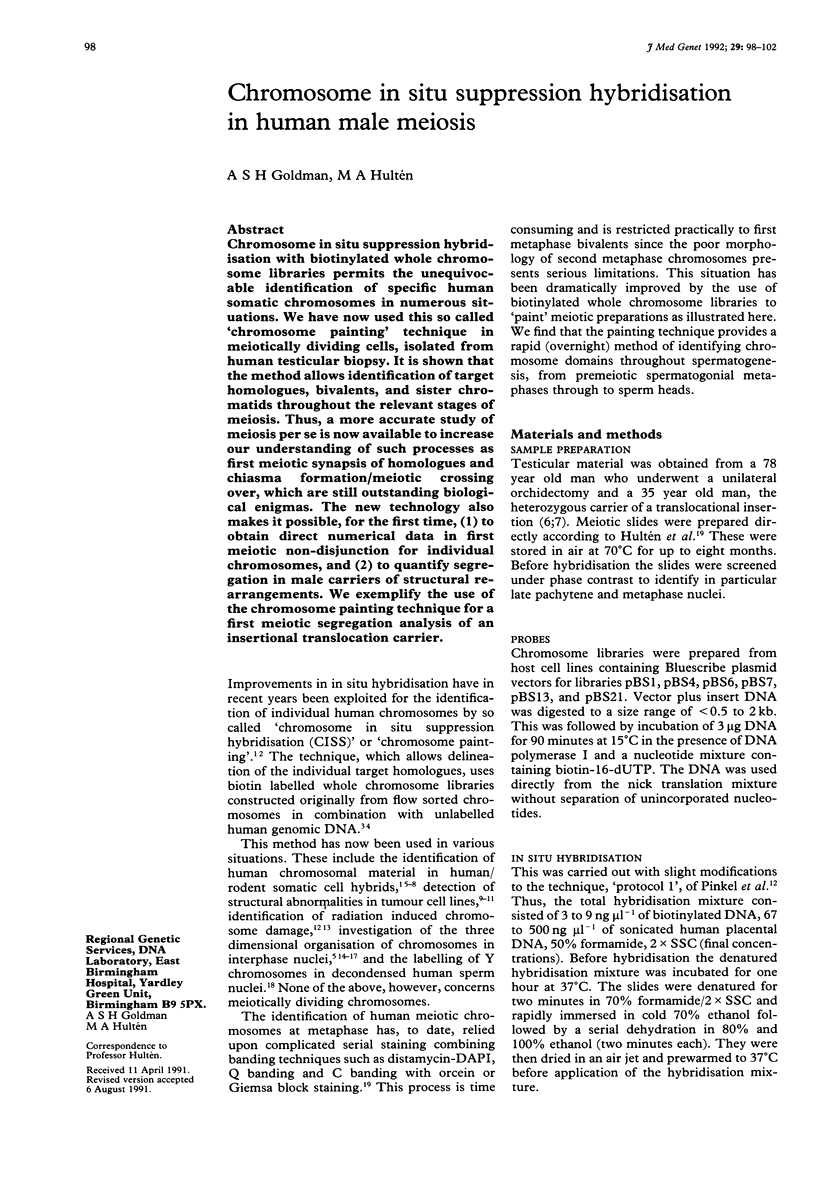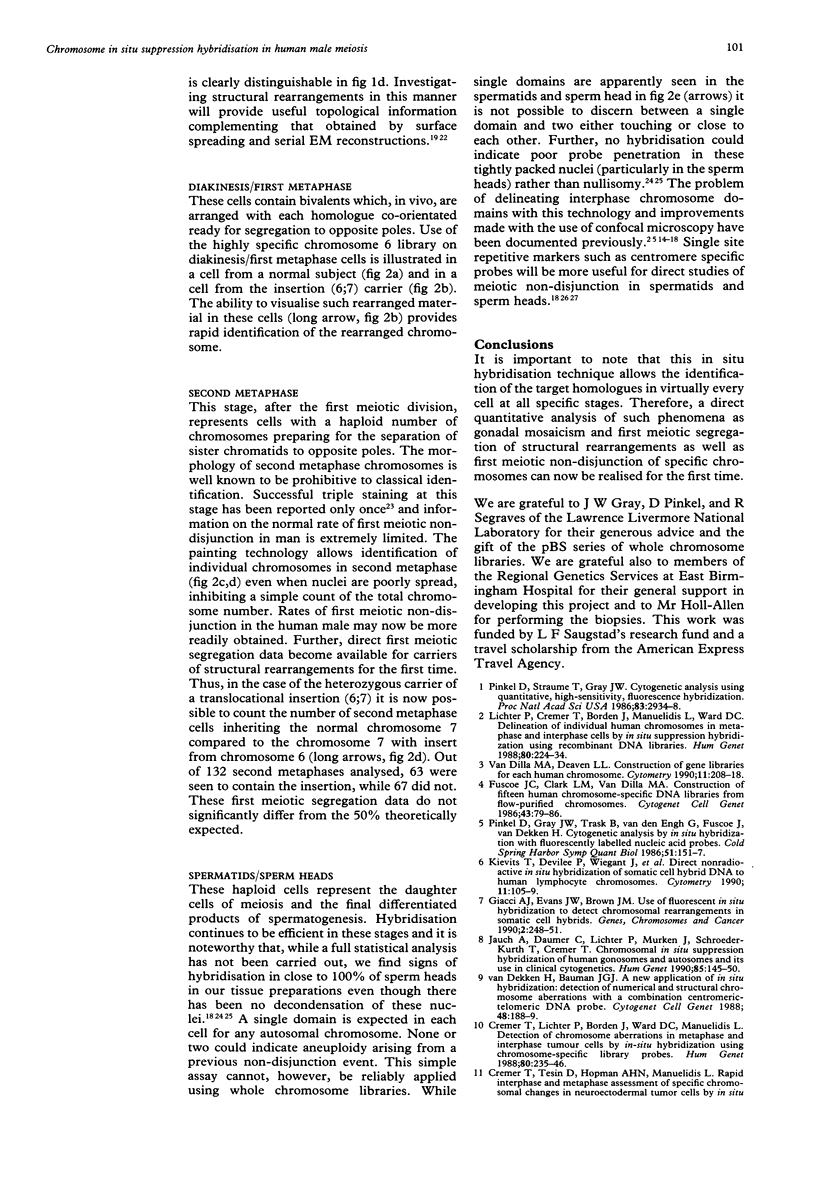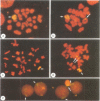Abstract
Chromosome in situ suppression hybridisation with biotinylated whole chromosome libraries permits the unequivocable identification of specific human somatic chromosomes in numerous situations. We have now used this so called 'chromosome painting' technique in meiotically dividing cells, isolated from human testicular biopsy. It is shown that the method allows identification of target homologues, bivalents, and sister chromatids throughout the relevant stages of meiosis. Thus, a more accurate study of meiosis per se is now available to increase our understanding of such processes as first meiotic synapsis of homologues and chiasma formation/meiotic crossing over, which are still outstanding biological enigmas. The new technology also makes it possible, for the first time, (1) to obtain direct numerical data in first meiotic non-disjunction for individual chromosomes, and (2) to quantify segregation in male carriers of structural rearrangements. We exemplify the use of the chromosome painting technique for a first meiotic segregation analysis of an insertional translocation carrier.
Full text
PDF




Images in this article
Selected References
These references are in PubMed. This may not be the complete list of references from this article.
- Cremer T., Lichter P., Borden J., Ward D. C., Manuelidis L. Detection of chromosome aberrations in metaphase and interphase tumor cells by in situ hybridization using chromosome-specific library probes. Hum Genet. 1988 Nov;80(3):235–246. doi: 10.1007/BF01790091. [DOI] [PubMed] [Google Scholar]
- Cremer T., Popp S., Emmerich P., Lichter P., Cremer C. Rapid metaphase and interphase detection of radiation-induced chromosome aberrations in human lymphocytes by chromosomal suppression in situ hybridization. Cytometry. 1990;11(1):110–118. doi: 10.1002/cyto.990110113. [DOI] [PubMed] [Google Scholar]
- Cremer T., Tesin D., Hopman A. H., Manuelidis L. Rapid interphase and metaphase assessment of specific chromosomal changes in neuroectodermal tumor cells by in situ hybridization with chemically modified DNA probes. Exp Cell Res. 1988 Jun;176(2):199–220. doi: 10.1016/0014-4827(88)90325-4. [DOI] [PubMed] [Google Scholar]
- Eastmond D. A., Pinkel D. Detection of aneuploidy and aneuploidy-inducing agents in human lymphocytes using fluorescence in situ hybridization with chromosome-specific DNA probes. Mutat Res. 1990 Oct;234(5):303–318. doi: 10.1016/0165-1161(90)90041-l. [DOI] [PubMed] [Google Scholar]
- Fuscoe J. C., Clark L. M., Van Dilla M. A. Construction of fifteen human chromosome-specific DNA libraries from flow-purified chromosomes. Cytogenet Cell Genet. 1986;43(1-2):79–86. doi: 10.1159/000132301. [DOI] [PubMed] [Google Scholar]
- Giaccia A. J., Evans J. W., Brown J. M. Use of fluorescent in situ hybridization to detect chromosomal rearrangements in somatic cell hybrids. Genes Chromosomes Cancer. 1990 Sep;2(3):248–251. doi: 10.1002/gcc.2870020314. [DOI] [PubMed] [Google Scholar]
- Jauch A., Daumer C., Lichter P., Murken J., Schroeder-Kurth T., Cremer T. Chromosomal in situ suppression hybridization of human gonosomes and autosomes and its use in clinical cytogenetics. Hum Genet. 1990 Jul;85(2):145–150. doi: 10.1007/BF00193186. [DOI] [PubMed] [Google Scholar]
- Kievits T., Devilee P., Wiegant J., Wapenaar M. C., Cornelisse C. J., van Ommen G. J., Pearson P. L. Direct nonradioactive in situ hybridization of somatic cell hybrid DNA to human lymphocyte chromosomes. Cytometry. 1990;11(1):105–109. doi: 10.1002/cyto.990110112. [DOI] [PubMed] [Google Scholar]
- Laurie D. A., Firkett C. L., Hultén M. A. A direct cytogenetic technique for assessing the rate of first meiotic non-disjunction in the human male by the analysis of cells at metaphase II. Ann Hum Genet. 1985 Jan;49(Pt 1):23–29. doi: 10.1111/j.1469-1809.1985.tb01672.x. [DOI] [PubMed] [Google Scholar]
- Lichter P., Cremer T., Borden J., Manuelidis L., Ward D. C. Delineation of individual human chromosomes in metaphase and interphase cells by in situ suppression hybridization using recombinant DNA libraries. Hum Genet. 1988 Nov;80(3):224–234. doi: 10.1007/BF01790090. [DOI] [PubMed] [Google Scholar]
- Manuelidis L., Borden J. Reproducible compartmentalization of individual chromosome domains in human CNS cells revealed by in situ hybridization and three-dimensional reconstruction. Chromosoma. 1988;96(6):397–410. doi: 10.1007/BF00303033. [DOI] [PubMed] [Google Scholar]
- Manuelidis L. Individual interphase chromosome domains revealed by in situ hybridization. Hum Genet. 1985;71(4):288–293. doi: 10.1007/BF00388453. [DOI] [PubMed] [Google Scholar]
- Meyne J., Littlefield L. G., Moyzis R. K. Labeling of human centromeres using an alphoid DNA consensus sequence: application to the scoring of chromosome aberrations. Mutat Res. 1989 Jun;226(2):75–79. doi: 10.1016/0165-7992(89)90046-8. [DOI] [PubMed] [Google Scholar]
- Pinkel D., Gray J. W., Trask B., van den Engh G., Fuscoe J., van Dekken H. Cytogenetic analysis by in situ hybridization with fluorescently labeled nucleic acid probes. Cold Spring Harb Symp Quant Biol. 1986;51(Pt 1):151–157. doi: 10.1101/sqb.1986.051.01.018. [DOI] [PubMed] [Google Scholar]
- Pinkel D., Landegent J., Collins C., Fuscoe J., Segraves R., Lucas J., Gray J. Fluorescence in situ hybridization with human chromosome-specific libraries: detection of trisomy 21 and translocations of chromosome 4. Proc Natl Acad Sci U S A. 1988 Dec;85(23):9138–9142. doi: 10.1073/pnas.85.23.9138. [DOI] [PMC free article] [PubMed] [Google Scholar]
- Pinkel D., Straume T., Gray J. W. Cytogenetic analysis using quantitative, high-sensitivity, fluorescence hybridization. Proc Natl Acad Sci U S A. 1986 May;83(9):2934–2938. doi: 10.1073/pnas.83.9.2934. [DOI] [PMC free article] [PubMed] [Google Scholar]
- Trask B., van den Engh G., Pinkel D., Mullikin J., Waldman F., van Dekken H., Gray J. Fluorescence in situ hybridization to interphase cell nuclei in suspension allows flow cytometric analysis of chromosome content and microscopic analysis of nuclear organization. Hum Genet. 1988 Mar;78(3):251–259. doi: 10.1007/BF00291672. [DOI] [PubMed] [Google Scholar]
- Van Dilla M. A., Deaven L. L. Construction of gene libraries for each human chromosome. Cytometry. 1990;11(1):208–218. doi: 10.1002/cyto.990110124. [DOI] [PubMed] [Google Scholar]
- Wyrobek A. J., Alhborn T., Balhorn R., Stanker L., Pinkel D. Fluorescence in situ hybridization to Y chromosomes in decondensed human sperm nuclei. Mol Reprod Dev. 1990 Nov;27(3):200–208. doi: 10.1002/mrd.1080270304. [DOI] [PubMed] [Google Scholar]
- van Dekken H., Bauman J. G. A new application of in situ hybridization: detection of numerical and structural chromosome aberrations with a combination centromeric-telomeric DNA probe. Cytogenet Cell Genet. 1988;48(3):188–189. doi: 10.1159/000132622. [DOI] [PubMed] [Google Scholar]
- van Dekken H., Pinkel D., Mullikin J., Trask B., van den Engh G., Gray J. Three-dimensional analysis of the organization of human chromosome domains in human and human-hamster hybrid interphase nuclei. J Cell Sci. 1989 Oct;94(Pt 2):299–306. doi: 10.1242/jcs.94.2.299. [DOI] [PubMed] [Google Scholar]




